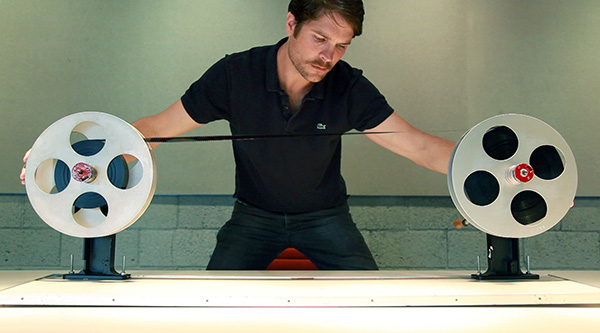

Cinelicious Thinks Big
LOS ANGELES, January 2013 – While Cinelicious describes itself as a next-gen post house, clients have been known to refer to it as a “playground for film fanatics.” That perception is no accident Founder Paul Korver is a self-taught filmmaker whose experience was the driving force behind Cinelicious (www.cinelicious.tv), a company that would provide workflow solutions for all formats. The environment, both physically and philosophically, would embody discovery and openness.
“This process is a fine-tuned balance of artistry and process,” says Korver “Intensive research backs everything we do. It can feel obsessive, but our clients appreciate our compulsiveness and shared passion.”
As a result, Cinelicious has been involved with directors such as Stephen Spielberg, J.J. Abrams, Christopher Nolan and Andrew Stanton; studios like Paramount, Disney, Pixar, and Warner Bros.; and film libraries.
4K DI THEATER
Many of the projects used the Scanity 4K film scanner, which was acquired after a year-long market and technology analysis with side-by-side testing. Last year: with an eye toward the future of digital cinema and feature film mastering, Cinelicious designed and built a 4K digital intermediate theater that allows realtime 4K color correction from 4K DLP projection.
As Korver explains, “4K is exploding right now with a massive roll out of 4K projectors in commercial cinemas, as well as a big 4K/ Ultra HD Home Television push from Sony, Samsung. LG and Toshiba at CES in January. For producers, having 4K content is going to be key and whether it’s remastering an older 35mm feature or TV show to 4K, or working with new 4K digitally-acquired footage, traditional 2K monitoring is no longer enough.
Having the tools and talent to provide pixel- for-pixel 4K review and mastering is something we’ve gone to great lengths to provide, and our clients are blown away when they see their images at true resolution.”
PRINCE AVALANCHE
Sundance Film Festival entry Prince Avalanche, directed by David Gordon Green and with cinematography by Tim Orr, was the first feature to be completed in Cinelicious’ 4K DI theater. Cinelicious handled all mastering. Including 2K DCDM, DCP, HDCAM-SR. Blu-Ray, DVD and all file-based deliverables, with color by feature colorist Alex Bickel.
“Prince Avalanche was David’s first digitally shot film and it was important that the resulting footage did not feel like an aesthetic sacrifice in any way,” says Bickel. “The entire film takes place in woods that have been recently ravaged by a forest fire, so it’s quite a surreal, charred landscape in the middle of a rebirth. Tim and David both wanted to create a very rich, saturated and slightly surreal aesthetic in the grade. It was also important that the flares hold detail and roll off like they would on film.”
Korver, who supervised the film’s DI, adds, “We chose a workflow and color science that would preserve creative integrity and color fidelity across today’s plethora of digital and analog distribution outlets. One that not only allows for flawless P3, Rec 709, Rec 6Ol and sRGB deliverables, but would protect for the possibility of future Arrilaser film recording should the film’s distributors require 35mm release prints or the producers simply want an archival negative for long-term preservation.”
SANTA MONICA THEATER
Meanwhile, just as Cinelicious was completing the Sundance-bound feature, the company was opening a Santa Monica theater within visual effects and design company Big Block, to better serve commercial advertising clients. The new Santa Monica theater is specifically designed to achieve perfect Rec 709 colorspace for broadcast finishing as well as P3 for digital cinema feature film deliverables.
“For a new experience in commercial finishing, our color science team collaborated with Barco to optimize a new Series 2 DLP with projector to achieve a brightness and contrast ratio that is beyond what is typically seen in digital cinema which allows us to emulate the blacks and colorspace of a broadcast display flawlessly, minus the shortcomings of Plasma and LCD technology. We’ve coined this experience ‘Big TV’ and our commercial clients are loving it” explains Korver. “ln this emerging world of large, high-resolution home displays it makes sense that commercial creatives want to interact more intimately with their images than they have been used to in a typical telecine suite with 24- or 40-inch mastering monitors. Big TV is an exciting new approach that affords them that opportunity.”
The room boasts a new 17-foot Stewart Solid Snowmatte 100 film screen, supports
3D stereo and high frame rate (120 fps) playback, has seating for 15, and 7.1 surround for pristine audio and picture.
Also part of the Santa Monica expansion was the addition of veteran colorist Robert Curreri, who has contributed his talent to hundreds of spots for such clients as Honda, Toyota, Sprint, Reebok, Wachovia, Bud Light, Yahoo, Target, and Volkswagen.
“In a city as large as LA, geography and talent play critical roles in serving specific industry sectors.” notes Korver. “Like our simultaneous emphasis on film and digital, our clients come from features and advertising. In the advertising arena, our relationship with Big Block benefits both their clients and ours, with expanded services and the timeless adage ‘Location, location, location.”
When not in use, Korver intends to use both locations for screenings and events. He’s already hosted Super 8 film clubs and an evening dedicated to 4K projectors for DPs “This is a time of incredible innovation and opportunity to preserve our cinematic history.” – POST MAGAZINE.
